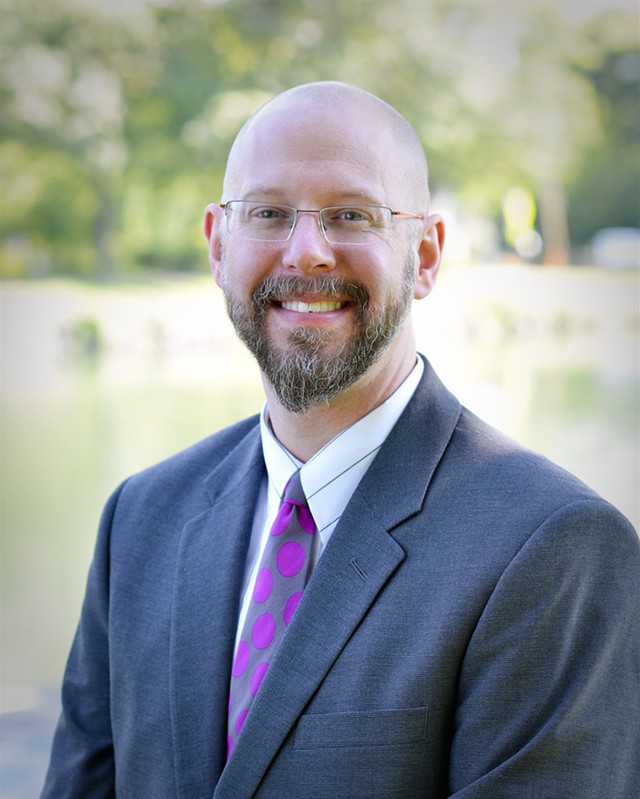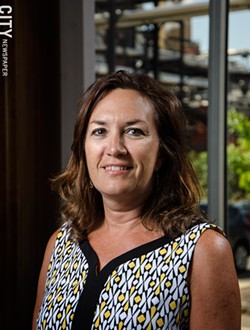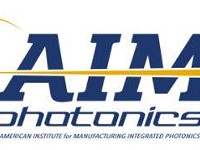
[
{
"name": "500x250 Ad",
"insertPoint": "5",
"component": "15667920",
"parentWrapperClass": "",
"requiredCountToDisplay": "1"
}
]
This article has been corrected.
Rochester was handed a big task when the Department of Defense picked the city to anchor a national photonics effort. The region has a central role in growing a domestic ultra-high-tech industry out of research, lab projects, and the few super-high-end products already on the market.
It's been a year, almost to the day, since Vice President Joe Biden flew into town to announce that Rochester would be the home of what's now known as AIM Photonics. That news generated a lot of excitement, especially among politicians who boldly predicted that the effort would lead to thousands of jobs.
Those jobs haven't materialized yet, but local companies and people involved in the initiative aren't worried. Integrated photonics — which weds miniaturized optical systems with electronic computer chips — is an industry that's just found its footing, they say. Job growth will come a few years down the line, after companies get to a point where they have mature products ready to be manufactured, they say.
"What people didn't understand when the announcement got made was nobody is making these things yet," says Tom Battley, executive director of Rochester Regional Photonics Cluster and New York Photonics, a trade association and lobbying group. "They're still trying to figure out how to do it. So the research and development portion is needed before any manufacturing gets done, and there's really nothing to make yet."
The nascent effort had a rocky start. A few months in, a dispute over the location of AIM Photonics' headquarters went public in an ugly way. The feud was between some local leaders and representatives of SUNY Polytechnic Institute, which is in charge of AIM Photonics operations.
Legacy Tower, which is the former Bausch + Lomb office building, was ultimately chosen for the headquarters, but the clash caused many people to wonder whether the photonics institute was doomed before it even got off the ground.
But some in the local photonics industry say that the quarrel, while certainly not helpful, amounted to growing pains with little lasting impact.
Bryce Tennant, chief technology officer for Brockport-based Precision Optical Transceivers, says that sort of struggle would probably have happened anywhere. He's not worried about it and his company would rather focus on helping the broader effort succeed, he says. (The company has been part of AIM Photonics for a while, but officially became a member in late June.)
"AIM is a fantastic opportunity put in our lap," Tennant says.
The effort has momentum, he says. Universities and companies, including Precision Optical Transceivers, are working on projects through AIM Photonics. And more partners are coming on board.
Another sign of progress: a state board recently approved $106 million in funding for operations and key facilities in the state. The majority of that money — $95 million — will be used to buy equipment and cover other costs to outfit a critical photonics tech development and testing facility in the Rochester area.
The budget is an important milestone, since it shows that AIM Photonics is serious about one of its primary objectives: getting technology out of research and development and into marketable products. The money also reaffirms the Rochester region as the hub of the broader national photonics initiative.
AIM Photonics is a massive undertaking. Within five years, the photonics collaborative is supposed to be self-sustaining and showing real gains toward developing a national photonics development and manufacturing industry.
Why doesn't Rochester have more photonics jobs yet?
The main reason is that companies have to develop things to manufacture. Manufacturing is where AIM Photonics representatives and participants expect the largest job gains, but that work is still a few years away.
Integrated photonics technologies aren't a pipe dream; they're already on the market in some of the very powerful (and expensive) switches that route massive amounts of traffic into, out of, and inside of data centers. Other researchers and firms have developed experimental products, such as biomedical sensors.
AIM Photonics' end goal is manufacturing; the US Department of Defense wants these technologies developed and produced domestically. So it's bringing together companies small and large, as well as academics, to work together to develop technologies and to transition them from labs to factories.
These companies and researchers will be able to license their innovations in some cases, and generally will be able to pursue some financial benefit from them, says Laura Magee, a spokesperson for Empire State Development. In other words, companies will have incentive to invest resources into research, development, and commercialization work.
Down the road, new jobs will be created through research and development work. Tennant says that Precision Optical Transceivers, which has 20 employees, plans to hire additional engineers as AIM Photonics grows, for example.
State and local leaders also expect that companies in the field will want to have a presence close to the resources that'll be available in the Rochester region. That may mean that out-of-area companies relocate here or open offices here, and either scenario could mean job gains for the region.
A handful of high-level positions have been filled. Some are essentially operations jobs; Ed White, a longtime Kodak executive, was hired to handle corporate relations for AIM Photonics, a move that has drawn praise. The photonics institute has also made technical hires for a forthcoming development and testing facility, though some of those people were already part of AIM, Magee says.
Representatives from Empire State Development and SUNY Polytechnic did not provide the number of hires.
Monroe Community College, University of Rochester, and Rochester Institute of Technology have workforce development programs in the works to make sure that Rochester residents are able to get photonics-related jobs, and that the companies have the scientists, engineers, and manufacturing workers needed to make their products.
What's this development and testing facility, and the $95 million set aside for it all about?
The testing, assembly, and packaging facility, as it's called, is the first big investment for AIM Photonics, and it's a crucial part of the whole effort. Dolores Kruchten, who is Kodak's vice president for the Eastman Business Park, says nothing like it exists in the United States as far as she knows.
There may be good reason for that: the equipment is too expensive for most companies to buy and install on their own. But a collaborative, multi-user facility such as TAP would give companies access which, in turn, will help get their products into production.
In short, the state buys the equipment, sets up the facility, and then the dues-paying members that belong to the collaborative — AIM Photonics in this case — get access in order to work on their products. SUNY Polytechnic used a similar model to build up the Capital Region semiconductor industry.
Albany's semiconductor foundries will fabricate silicon wafers — completed photonics chips, basically — designed by AIM Photonics members. Silicon wafer production is complicated, and since Albany already has the facilities and expertise, it makes sense for the work to happen there.
But the wafers will then be sent to Rochester's TAP facility, where companies will "package" and assemble the chips for use in products, and test the chips as well as the systems that they're components of.
"That's the Rochester portion of how we're going to benefit from this in terms of direct connection," Battley, of the trade association says. "We will take the devices; slice them, dice them, test them, and integrate them into packages that people can then put in their products."
Packaging wafers is a complex process that goes beyond simply covering them with materials such as glass, plastics, or other materials. The photonics chips are tiny and extremely sensitive. And during packaging, light sources have to be connected to the almost microscopic optical channels in the chip. It's precise, time consuming work.
Packaging is the most expensive part of making a complete photonics chip, says Bob Duffy, chair of the AIM Photonics Leadership Council and president of the Greater Rochester Chamber of Commerce.
Where will the TAP facility be located?
This is one of the next big decisions around AIM Photonics. Empire State Development, which is the state's economic development arm, will solicit proposals for the location, but the two front runners are Kodak-owned Eastman Business Park and SUNY Polytechnic-owned space at Canal Ponds Business Park in Greece.
It's possible, though unlikely, that neither site is chosen; TAP could also be split between more than one site, Duffy says. So some equipment and work could go to Canal Ponds, some to Eastman Business Park, for example.
The money budgeted for TAP equipment and renovation is site-neutral, and the decision on the location will be based on technical specifications developed by some of AIM Photonics' scientific leaders, Duffy says.
Canal Ponds and Eastman Business Park have clean room, assembly, lab, and office space in single buildings. All of those are necessary for TAP.
Kodak's Kruchten says that Eastman Business Park is built for R&D and manufacturing work, and that the staff has experience scaling-up complex technologies and products for production.
The park also has space that companies, including start-ups, can move into, she says. State officials have already pegged Eastman Business Park as a likely location for photonics manufacturing operations.
Ultimately, Kruchten expects activity at Canal Ponds, Eastman Business Park, and other locations.
"With the size of this project, I think you're going to find every clean room in Rochester and broader that will be leveraged," she says. "The thing no one knows is how long will that take, from when they have their first product or their first piece that's packaged, to when it actually starts going into product."
Some of Eastman Business Park's backers point to another reason that the park should get the TAP facility: state and federal investigations into SUNY Polytechnic. The investigations center on whether SUNY Poly President Alain Kaloyeros and a lobbyist hired by the school, Todd Howe, rigged bids for certain projects. The federal investigation deals with the Buffalo Billion, while the state investigation deals with a SUNY Poly dorm.
They say that Canal Ponds could get caught up in legal complications if the investigations lead to charges.
It's not clear when a decision on the TAP facility's location will be made, since Empire State Development hasn't released its proposal request. But Duffy says that the facility should be up and running by the end of 2017 or early 2018.
What kinds of projects will local companies work on?
Some local optics and photonics companies are hanging back and waiting to see where the overall effort heads. Precision Optical Transceivers is not one of them.
The company produces optical transceivers, which are essential in fiber optic networks. They receive encoded light from the fibers, translate it into data that a device's chips can use, and transmit encoded light back into the network. Some of the company's transceivers are used in fiber Internet modems, for example.
Data communication just so happens to be a focus area for AIM Photonics. And Precision Optical Transceivers wants to provide better systems for its customers, which means driving up the quality and speed of its equipment while cutting down its power usage and costs. The company sees integrated photonics technologies, particularly the subset of silicon photonics, as the way to accomplish that.
Precision Optical Transceivers has already started on a project through AIM Photonics, working with professors at Rochester Institute of Technology and Columbia University. Another company is working on the same project, so there will probably be a chance for the businesses to collaborate, Tennant says. Because intellectual property is involved, however, Tennant couldn't discuss details.
It's costing the company money and time to participate in AIM Photonics; it's a Tier 3 member, and is covering its $100,000 obligation partly in cash and partly through in-kind contributions, Tennant says. And it wants to move up a tier within the next year.
But Tennant considers the cost an investment. Within five years, the company will have access to a cutting-edge factory, will have better products to offer customers, and will have built connections across the photonics industry and academia, he says.
"How do I put a number on that investment?" Tennant says. "You can't."











